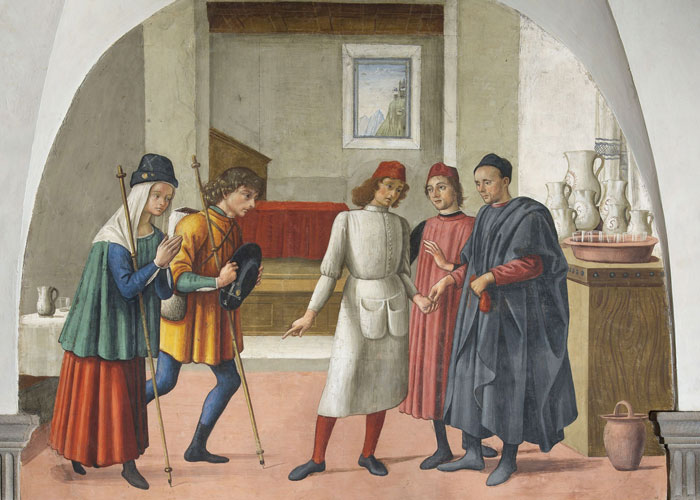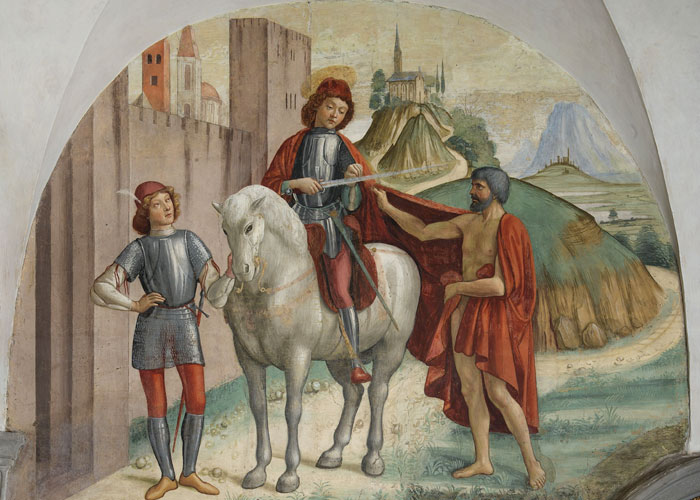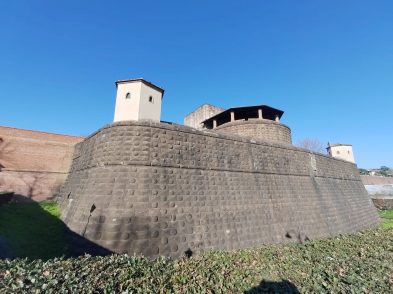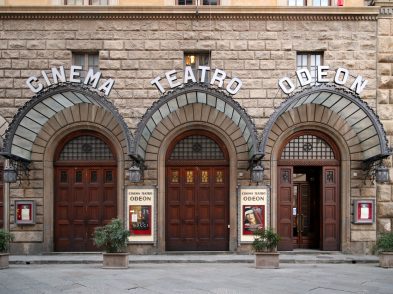Should you find yourself in the centre of Florence, meandering among the narrow streets and hidden squares, you might wander into the small piazza San Martino, at the end of via de’ Magazzini, on the corner of via Dante Alighieri. There you will see the Oratory of the Confraternity of the Buonomini of San Martino, rebuilt by its members in 1479. A portrait of Saint Antonino appears in a lunette above the door, while on the facade next to the door a tabernacle depicts the charity of Saint Martino, giving alms to the poor. This is above the buca, or dropbox, in the wall where monetary offerings can still be left today.

After Cosimo di Giovanni de’ Medici (1389-1464), known as Cosimo the Elder, returned from exile in 1434, he began to consolidate his influence over the government in Florence, eradicating the factionalism caused by rival families like the Pitti, Albizi and Soderini. He did this by engineering a series of constitutional amendments with the help of compliant members of the Signoria and by exiling his enemies or confiscating their property and wealth. In this climate, and as an ecclesiastical form of passive resistance against autocratic rule, the then preaching Dominican prior of the San Marco Basilica, Antonino Pierozzi (1389-1459), founded the confraternity, also called the Congregation of the Procurators of the Shameful Poor. The prior’s idea was to unite 12 pious men to help these disgraced, or in this sense, “shameful” noble families, who were ashamed to beg because of their former standard of living, as well as the sick, pregnant women without family support, those in debtors’ prison and foreigners. The task of these 12 men, soon assisted by six helpers, was to collect funds, seek out the needy and distribute the alms throughout Santo Spirito, San Giorgio, Santa Croce, Sant’Ambrogio, Santa Maria Novella and San Giovanni.
Word about the 12 men’s charitable deeds soon began to circulate around the city, resulting in their moniker of the buonomini (“good men”) of Florence. The pope at the time, Eugenio IV, dubbed them the “angels of Florence”, while Girolamo Savonarola (1452-98), the fire and brimstone monk, donated 3,000 florins to the confraternity during his brief rule, which was paid by taxing the clergy of the Republican diocese.

Today, more than five centuries after their founding, the Buonomini live by the same rules, relying on charitable donations from Florentines and others who believe in their mission. Up until 1949, when funds ran low, they lit a small candle in a lamp outside the oratory, which gave rise to the Tuscan expression essere al lumicino (in English, “to be broke”). Every Friday afternoon after a short prayer, the Buonomini gather to decide how to distribute the aid and to discuss issues that concern the congregation. All of these consultations are strictly confidential to protect the dignity of those who receive aid. Should a Buonomino die or be forced to renounce for any reason, he must be replaced. The others meet at the San Marco Basilica and light a candle, seeking guidance from Saint Antonino. The following week, they hold a secret vote to choose from among the proposed candidates and the person with the majority is elected. Two Buonomini then contact the chosen man to ask if he is willing to accept the position.
The beautiful frescoes in the oratory, last restored in 2011, are attributed to the workshop of Domenico Ghirlandaio. They depict scenes from the life of Saint Martino, such as when the soldier-saint gifted a part of his cloak to a beggar and when he dreamed that Jesus was wearing half of the same cloak as he tells the angels that Martino had given it to him. Other frescoes illustrating the Buonomini’s charitable deeds are of considerable historical value because they represent everyday life as it was in 15th-century Florence. Although the Buonomini wore no special uniform, unlike many of the other confraternities, including the Misericordia, they are easily recognizable in these frescoes as they all wear what was called the lucco (a mantle, usually black or red, which symbolized their elevated social class).
The historic archive of the activities of the Confraternity of the Buonomini of San Martino is one of the most varied in Florence as it has always been scrupulously maintained and enriched over the centuries. It also contains two important private archives that were donated by the last descendants of two historic Florentine families, the Gianfigliazzi and the Minerbetti.
In this long story of taking and giving rather than giving and taking, the role of Prior Antonino is pivotal. He would go on to become the much-loved and respected Archbishop of Florence from 1446 until his death in 1459, and rose to sainthood in 1523. His bust attributed to Verrocchio can be seen on the altar of the oratory, while a statue of him appears on the facade of the Santa Maria del Fiore Cathedral. He is also the only cleric to feature in a niche among the sculpted figures in the external gallery of the Uffizi.
The Oratory of the Buonomini of San Martino in piazza San Martino can be visited every day between 10.30am-12.30pm, 2.30-5pm, except Friday and Saturday afternoons and Sundays, when it is closed to the public. For further information, email info@buonominidisanmartino.it







